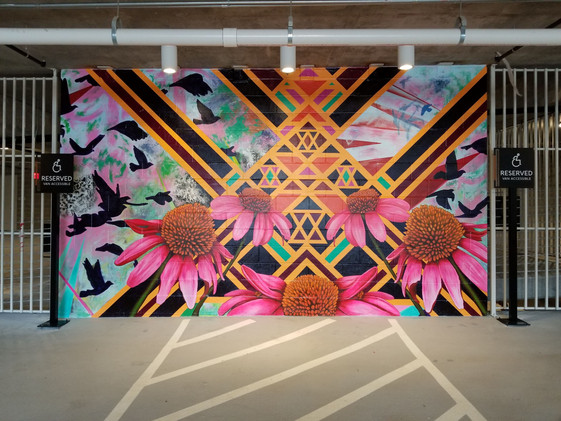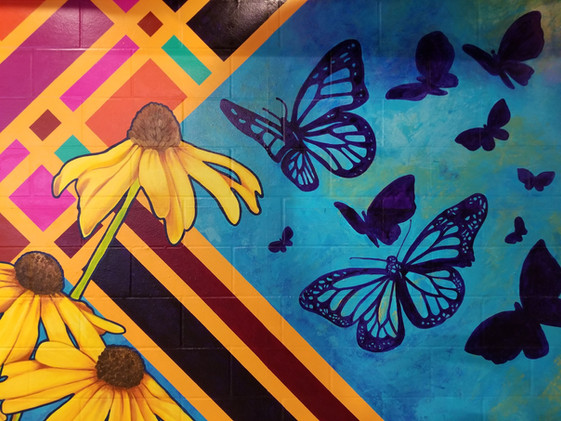
HAVEN
Artist: Patricia A. Barrera
Assistant: Christopher Richards
Site: Drewery Place (2850 Fannin St. Houston, TX)
This mural was commissioned by Caydon USA through Houston Arts Alliance.
About the Project
Home has always been a gathering place, shelter, and sanctuary, providing escape from the busyness and intrusiveness of the world. A home can take many different forms, but are universally essential as places where people dream, create, and grow. For many, home is not a fixed place. We often find sanctuary spaces around us or in our imaginations, developing a sense of home wherever it needs to be.
In recent times, home has become a problematic notion, not only because of everyday encounters with our homeless fellow citizens, but also because of the great increase in immigrants, refugees, asylum-seekers, and victims of natural disasters in many parts of the world. Given the strong meanings and emotional associations that home has for us, those who have lost their homes and the things they most valued, or who have never had a proper home in the first place, face psychological impacts and identity crises of massive proportions. Being without a home is devastating on personal, social, and many other levels.
My goal is to raise awareness and spark conversations about what home is for us and to inspire people to connect with others, experience compassion, for others and ourselves, make contributions that are meaningful and life-affirming, and have the courage to tell our stories and speak our truths. At the end, we share Earth as our ultimate home and thinking about home takes us into our inner selves and also encourages us to look at things in their totality.
For better or worse, by presence or absence, home is a crucial point of reference—in memory, feeling, and imagination—for creating the story of ourselves, our life-narrative, and for understanding our place in time. But, it is also a vital link through which we connect with others, with the world, and the universe at large. This mural design celebrates the sanctuaries in our lives that allow us to be extraordinary parts of the communities that we create.
WALL 1
Migratory birds are symbols of peace and of an interconnected planet. They connect people, ecosystems and nations. Inspired by their freedom of movement, their “mastery of the air”; their ability to see from widely and wildly divergent perspectives in spectrums of color beyond what is visible to humans; their capacity to change environment when biology or circumstance calls. Rootedness and flight. Home and escape.
To CONNECT with others, experience COMPASSION, for others and ourselves, make CONTRIBUTIONS that are meaningful and life-affirming, and have the COURAGE to tell our stories and speak our truths”. In this first wall the geometric pattern represents the word CONNECT.
The flowers are Eastern Purple Coneflowers, a drought tolerant Houston native that is a butterfly magnet. The juxtaposition between the native flowers and the migrating birds reminds the viewer about the importance of empathy, to put aside our viewpoints, and try to see things from another person's point of view.
WALL 2
The design incorporates a number of natural elements, as well as geometric shapes. The content is very much inspired by nature, Zen philosophies and wabi-sabi concepts of transience. A huge part of the wabi-sabi concept is the acceptance of nature and natural processes. The elements (Fire, Wind, Water, Earth) can drastically change the qualities of both natural and man made materials. Decay, erode, develop patina: transience and imperfection. Temporality of life and the renewal process in nature, a continuum and infinite.
The Enso gold circle: The beauty of imperfection. In Zen, ensō (円相 , "circle") is a circle that is hand-drawn in one or two uninhibited brushstrokes to express a moment when the mind is free to let the body create. The ensō symbolizes absolute enlightenment, strength, elegance, the universe, and mu (the void). The circle may be open or closed. In this case, the circle is incomplete, allowing for movement and development as well as the perfection of all things.
The geometric pattern in the background is conformed of a variety of shapes that include circles, triangles and hexagons. Within some of these shapes are symbols that represent empathy, compassion, gratitude, transformation, exploration, and creation. As a whole, they represent the words COMPASSION and CONTRIBUTIONS from the quote mentioned above.
The birds are placed on the design in a mandala style to represent the connection between our inner worlds and outer reality. Birds represent having the wings of possibilities, freedom of flight, precision and timing, perspective, vision and individuality. Hummingbirds, in their seemingly carefree and happy flight, remind us to live in the moment and enjoy life’s pleasures. Also, because they often seem to appear out of nowhere, they remind us that joy is unpredictable and can often be just around the corner. With their long, thin beaks, they can reach beyond the tough, untasty parts of a flower to find the sweet nectar within. In this way, they remind us to always be seeking out what’s good in life. Furthermore, because of their ability to fly backwards, sideways and hover up and down, they remind us to stay adaptable and to accept the reality of change with a happy heart.
WALL 3
Monarch butterflies are deep and powerful representations of life. Many cultures associate the butterfly with our souls. Around the world, people view the butterfly as representing endurance, change, hope, and life. To me, the monarch butterfly is a symbol of fluid and peaceful migration and represents the dignity and resilience of migrants, and the right that all living beings have to move freely.
The geometric pattern suggests a heart shape at the center of it representing love and COURAGE, the last part of the quote mentioned above.
Also a native Houston plant, the Black-eyed Susan flower represents transformation. The bright yellow halo of blossoms surrounding the dark inner core represent protection. The dark brown center of the flower, encourages us to go into the dark depths of our own center within. Its golden petal-like rays extend out from the dark center reaching towards the light; and they bring the light back to the flower’s dark center. This flower gives us courage to go into the unknown part of ourselves, prompting the process of inner healing to begin.
























